Discover the Richness of Dubai's Desert Safari Park
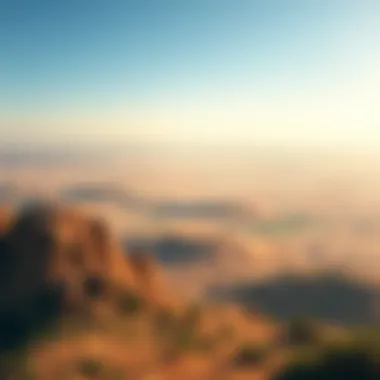

Intro
The Desert Safari Park in Dubai is not just a place where camels roam and tourists take selfies; it stands as a vivid testament to the delicate interplay between nature and human endeavor. Fostering a rich biodiversity, the park is an oasis of ecological significance nestled within a city known for its lavish lifestyles and towering skyscrapers. Alongside leisure, it raises profound questions about sustainable tourism.
When people think of Dubai, images of sleek buildings and bustling markets often spring to mind, but the Desert Safari Park offers a slice of the natural world that begs exploration. With an increasing interest in ecotourism, understanding the park's role becomes imperative for anyone considering an investment in the region—be it for real estate or merely a way to soak up the local culture. Let's unpack the layers of this unique venue, from investment opportunities to its role in conservation.
Market Insights
The desert landscape infused with a thriving ecosystem sets the backdrop against which Dubai's bustling real estate market unfolds. Investors, homebuyers, and developers increasingly look at the integration of nature within urban growth; the market demand reflects this trend.
Latest Trends in Dubai Real Estate
Over the past few years, the real estate market in Dubai has seen a shift towards environmentally-friendly developments. Investors are keen on options that align with sustainable practices. With concepts like solar-powered buildings, green spaces, and even integrated wildlife habitats gaining traction, the market now recognizes the value of developments that respect their ecological surroundings.
- Increasing demand for green certifications
- Rise in eco-friendly construction materials
- Focus on projects that promote environmental stewardship
Impact of Global Events on Local Market
Global events, from the ongoing focus on climate change to the COVID-19 pandemic, have influenced real estate dynamics in Dubai. People now regard sustainability and health-conscious living as essential priorities rather than just passing trends. This reshapes the way investors view potential properties.
"Investors are waking up to the idea that sustainable properties are not just good for the planet; they're also wise investments."
The response to these global challenges indicates an ongoing transition towards properties that emphasize nature, encouraging those who create and sell real estate to align more closely with the shifting tides.
Investment Opportunities
For those considering investing in this growing ecosystem, it's essential to recognize which areas promise high returns while respecting environmental boundaries.
High-Return Areas for Property Investment
Focusing on regions close to the Desert Safari Park can yield beneficial returns. Properties near ecologically valuable locations typically see an uptick in interest.
- Properties near Nature Reserves
- Developments with Ecotourism Facilities
- Communities that Emphasize Sustainability
Tips for First-Time Investors
Investing in real estate, particularly in a place like Dubai, often feels like entering a labyrinth. But grasping a few key principles can simplify the process:
- Research market demands by closely observing trends.
- Prioritize properties that are both profitable and eco-conscious.
- Engage with local communities to gauge the area's environmental initiatives.
By keeping these factors in mind, investors can navigate through the glamorous but complex real estate market successfully.
Preamble to Desert Safari Park
The Desert Safari Park in Dubai stands as a unique intersection of nature and human innovation, presenting opportunities for both leisure and education. This park is more than just a destination; it embodies a commitment to preserving the rich biodiversity of the region while offering engaging recreational activities. Potential visitors and investors alike should grasp the essence of what makes this park not only a tourist hotspot but also a pivotal player in Dubai's ecological narrative.
Location and Accessibility
Situated just a stone's throw from the bustling heart of Dubai, the Desert Safari Park is strategically placed to ensure that it is both accessible and appealing. Travelers can navigate to the park using various modes of transportation, including taxis, private vehicles, and guided tours which often include convenient pick-up services from major hotels. The location is chosen meticulously so visitors can escape the urban hustle yet remain within reach of the city’s allure.
Moreover, several public transport options are available, including buses that connect to popular areas within Dubai. This ease of access has significantly contributed to the park's popularity among tourists and expatriates. With ample parking facilities and well-signed routes, planning a visit is straightforward—anyone can find their way to enjoy the serene beauty of the desert landscape.
Historical Significance
The historical backdrop of the Desert Safari Park tracks a fascinating tale that intertwines respect for tradition with a push for modernity. The region's cultural heritage is evident in the park’s carefully designed landscapes and educational programs. Historically, the desert was not just a barren land but a home to diverse species and a way of life for local tribes. The park acknowledges this legacy, incorporating elements that pay homage to the ancient ways of living in harmony with the desert.
Community engagement is a central pillar; through outreach programs and educational initiatives, the park preserves historical narratives that may otherwise fade into obscurity. Visitors often find programs about traditional desert survival, showcasing how knowledge of local flora and fauna was fundamental to the lifestyle of early inhabitants. This blend of historical significance with contemporary practices offers a profound understanding of the desert ecosystem's evolution over time.
In essence, the Desert Safari Park serves as both a hub for adventure and a reservoir of knowledge about the ecological and cultural heritage of the region. It invites various stakeholders—be they investors, developers, or informed guests—to appreciate its role as a linchpin in the ongoing dialogue about ecotourism, conservation, and Dubai’s growth.
Biodiversity and Flora
The Desert Safari Park in Dubai isn't just a place for thrill-seekers; it serves as a vital testament to the ecological diversity present in arid landscapes. This section explores the biodiversity and flora that thrive within the park's boundaries, revealing how this natural wealth contributes significantly to the park's overall allure and ecological aims.
Ecological Zones Within the Park
Within the park, you will find a captivating mix of ecological zones, each offering unique insights into the heart of desert life. Understanding these areas gives visitors a clearer portrait of how different species coexist and adapt to their environment.
Desert Ecosystem
The desert ecosystem within the park is a highlight, showcasing how flora and fauna have adapted to the harsh realities of their environment. Cacti, hardy shrubs, and resilient grasses thrive here, with frankincense trees standing tall against the backdrop of endless sand. These species have developed mechanisms to store water, allowing them to withstand long stretches without rainfall.
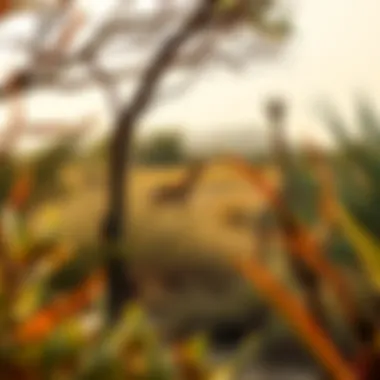
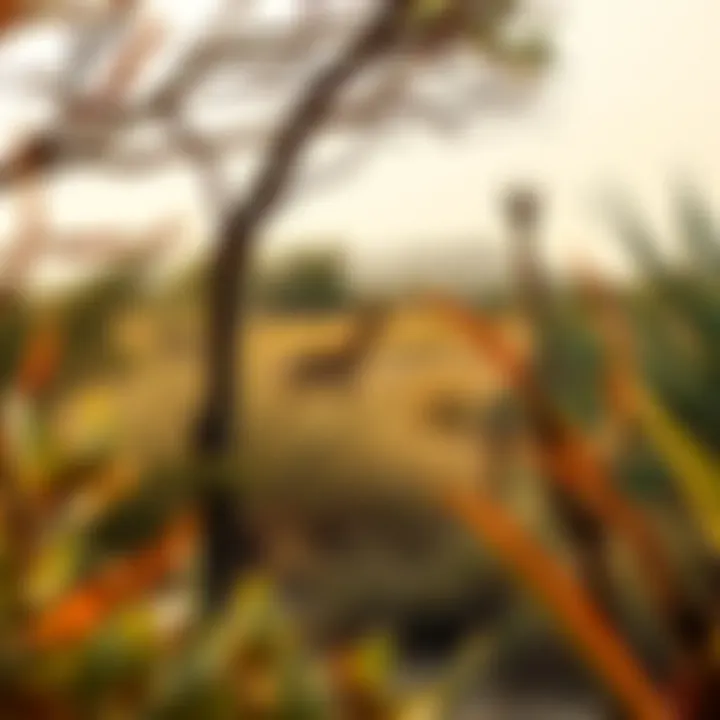
The key takeaway of the desert ecosystem is its ability to function as a living laboratory for researchers. Many visitors may find the stark beauty of the landscape enchanting, as they witness firsthand the ingenuity of nature. The unique feature of this ecosystem lies in the interdependence of species; animals like the Arabian Oryx or the sand gazelle rely on these plants for sustenance and shelter.
However, it's essential to recognize the fragility of this environment. Any disruption, whether from expanding tourism or climate change, can have far-reaching effects on its inhabitants.
Coastal Ecosystem
Just a breath away from the desert expanse, the coastal ecosystem brings a refreshing contrast. Here, mangroves and salt marshes create a lush habitat that supports a myriad of wildlife, from migratory birds to crustaceans. These zones play a crucial role in the health of the marine environment by filtering pollutants and acting as nurseries for fish.
Moreover, the coastal area's proximity to the desert underscores the unique relationships between different ecosystems. This dynamic offsets the harsher conditions found inland, showcasing a rich biodiversity that is distinct and vital. The advantage of the coastal ecosystem in this park is the diverse recreational opportunities it offers, like birdwatching or photography. Yet, it also bears the burden of rising sea levels and pollution threats, making conservation efforts critical.
Mountain Ecosystem
Rounding out the park’s ecological landscape is the mountain ecosystem, which presents a different set of physical and biological realities. Characterized by rugged terrain, home to small shrubs and flowering plants, these areas draw a cooler climate that allow specific species to flourish, such as various kinds of wildflowers and stalwart saguaro cacti.
What makes the mountain ecosystem beneficial is its role as a watershed, serving to capture rainwater that sustains both the plant and animal life below. Visitors might appreciate not just the picturesque views but also the biodiversity that these elevated zones foster. The drawback is that accessibility can be limited; hence, nurturing these areas requires thoughtful management to balance human interaction and conservation.
Native Species and Conservation Efforts
Ensuring the survival of native species is a priority for the Desert Safari Park. Conservation efforts focus on breeding programs for the Arabian Oryx and other species, aiming to bolster their numbers and genetic diversity. Throughout the park, educational programs aim to instill a sense of responsibility among visitors regarding wildlife preservation.
"The beauty of the desert is often overshadowed by its challenges; it is vital that we appreciate and protect the ecosystems that call it home."
Understanding these ecosystems offers a glimpse into not just how life endures in a harsh environment but also how we can play our part in nurturing this delicate balance.
Recreational Activities
The Desert Safari Park in Dubai isn't just a visual feast of arid beauty; it's a hub of thrilling recreational activities that engage visitors in the unique ecosystem. The essence of these experiences is critical as they not only provide leisure and entertainment but also support the park's overarching goal of conservation and education. By intertwining thrilling adventures with cultural experiences, the park creates lasting memories while fostering a deeper respect for the environment.
Safari Tours and Adventures
Camel Riding
Camel riding is an iconic part of the desert experience, immersing visitors in the traditional mode of transport used by Bedouins for centuries. This activity stands out because it connects individuals with the age-old practices of the desert nomads. For those who decide to take the plunge, the slow and steady pace of a camel ride allows for a unique perspective of the park's stunning landscapes.
One key characteristic of camel riding is its gentleness, which makes it accessible for all ages, from young children to older adults. It serves as a suitable gateway into desert exploration, allowing participants to appreciate the beauty of the surroundings without menacing speed or overwhelming noise.
However, it’s essential to note that while camel rides can be enjoyable, they may not suit everyone. Some visitors may find the height or the swaying motion uncomfortable. Still, the magical ambiance of gliding through golden sands atop a majestic creature offers an experience like no other, embodying the park's adventurous spirit.
Dune Bashing
Dune bashing, on the other hand, is a heart-pounding venture for adrenaline junkies. This activity involves traversing the undulating sand dunes in powerful 4x4 vehicles, sharply contrasting the serene experience of camel riding. Dune bashing showcases the thrilling capabilities of modern vehicles on sandy terrain, making it a popular choice among younger visitors looking for excitement.
The uniqueness of dune bashing lies in its exhilarating speed and the impressive skills of drivers who navigate steep slopes and sharp turns. It fosters a sense of camaraderie among participants as they share chances of laughter and surprise amid the bumps and thrills.
Despite its allure, dune bashing may pose risks, particularly for those who are prone to motion sickness or prefer tranquil environments. Nonetheless, it holds a firm place in the park’s array of offerings, contributing to the versatile recreational experiences available.
Cultural Experiences
Moving beyond just physical activities, cultural experiences within the park add dimension to visitors’ understanding of local traditions and heritage. These experiences are essential in promoting awareness and appreciation of Dubai's rich cultural tapestry among diverse audiences.
Traditional Dances
Traditional dances are lively expressions of the local culture that can captivate anyone. Visitors to the Desert Safari Park will find performances showcasing traditional Emirati folklore, which adds an educational aspect to their adventure. This activity not only entertains but also invites reflection on the meanings behind the music and movements tied to the history of the region.
One particular aspect that makes these performances appealing is the use of vibrant costumes and the melodic sounds of live music. Each dance narrates a story of love, heritage, or social gatherings, making it a potent reminder of cultural continuity.
The primary advantage of witnessing such performances is the opportunity to engage with the culture in a visceral way—something that cannot be replicated through written words alone. However, for some visitors, the unfamiliarity of the lively atmosphere may overwhelm, especially those who prefer a quieter setting.
Craft Workshops
Craft workshops provide another enriching cultural interaction. Here, visitors can learn about traditional handicrafts such as pottery and weaving from skilled artisans. These sessions foster a hands-on approach to understanding local artistry, which is integral to Emirati culture.
The highlight of participating in a craft workshop is the chance to create a personal memento to take home, connecting visitors to their experience in the desert long after their visit. These workshops not only support local artisans but also offer insights into the historic practices that formed the bedrock of community life.
However, the appeal of crafting can vary; some may prefer more passive experiences over active involvement. Yet, for many, it signifies a deeper connection to Dubai’s heritage, enhancing the essence of their adventure at the park.
As for potential investors, understanding these offerings can provide insights into the appeal of the park and its significance in the realm of ecotourism.
Visitor Experience
The experience of the visitor is often the heartbeat of any wildlife conservation area, and the Desert Safari Park in Dubai is no exception. Understanding how visitors engage with the park—what they do, how they feel, and what they take away from it—adds depth to the narrative of the park itself. It’s not just about the wild landscapes and exotic animals; it’s about the stories and the memories that people create during their time here. From the facilities that cater to comfort, to the guided tours that enlighten, the overall experience plays a vital role in promoting the park's ethos of conservation and appreciation for nature.
Park Facilities and Amenities


Dining Options
Dining options in the Desert Safari Park serve more than just sustenance; they enrich the visitor experience by offering a taste of local culture. Restaurants and food stalls serve traditional dishes made from fresh, local ingredients, giving visitors a flavorful introduction to Emirati cuisine. One standout feature is the option to enjoy meals outdoors, where guests can immerse themselves in the desert's tranquil atmosphere while sipping on freshly brewed Arabic coffee or enjoying a plate of shawrama.
The convenience of dining within the park cannot be overstated—it allows guests to refuel before heading back into excursions without having to leave the premises. Consequently, facilities cater to various dietary preferences, including vegetarian and halal options, making it an accessible choice for many. However, during peak visiting hours, the rush for seating can be overwhelming, and some may find wait times longer than ideal. Still, many visitors report that the unique flavors and cultural experience make the wait worthwhile.
Rest Areas
The rest areas within the Desert Safari Park are carefully designed havens where visitors can recharge during their expedition. These shaded zones are strategically placed throughout the park, allowing guests to take a breather from the sun while still being close to the action. Comfortable seating and lush greenery contribute to a sense of relaxation that is crucial in such an arid environment.
One of the unique aspects of these rest areas is the integration of informational displays. These zones don’t just provide a respite; they also educate visitors about the local fauna and flora, helping to deepen their appreciation for the ecosystem. However, during busy seasons, these spots can become crowded, slightly diminishing the serene experience they aim to offer. Yet, many people appreciate the opportunity to pause and reflect on their surroundings before diving back into their Dubai adventures.
Guided Tour Offerings
Guided tours at the Desert Safari Park bring a wealth of knowledge and a personal touch that enhances the visitor experience. Encounters with wildlife under the guidance of an expert can transform a casual visit into an immersive educational expedition. The tours often highlight conservation efforts, emphasizing why these ecosystems are worth protecting.
Different types of tours cater to various interests—from bird watching to nocturnal wildlife observations. They offer insightful anecdotes and facts that go beyond what one might simply find on a signpost. Additionally, the amiable guides often share local folklore and stories about the park’s history, bridging a connection between visitors and the land. However, it’s important to book these tours in advance, as they can fill up quickly, particularly during the busier months.
Through understanding these components of visitor experience, one can appreciate how the Desert Safari Park is not just an attraction but a thriving ecosystem that invites exploration and engagement from diverse audiences.
Sustainability Initiatives
In an era where climate change and environmental degradation are at the forefront of global discussions, the Sustainability Initiatives at the Desert Safari Park in Dubai stand as a beacon of hope. The park not only serves as an adventure playground but also embodies an ongoing commitment to ecological conservation and responsible tourism. This focus on sustainability is crucial, as it ensures the protection and restoration of the unique biodiversity found within the park while providing long-term economic benefits to the local community and visitors alike.
Conservation Programs
A cornerstone of the park’s sustainability efforts lies in its Conservation Programs. These initiatives aim to safeguard the native species and habitats within the park, many of which are threatened or endangered due to urban expansion and climate effects. The programs engage both the local community and international experts to facilitate a comprehensive approach to wildlife protection and habitat restoration.
- Habitat Restoration: Projects are in place to rehabilitate native flora and fauna, ensuring that ecosystems remain balanced and resilient. Techniques include planting indigenous vegetation and controlling invasive species.
- Wildlife Monitoring: Researchers and volunteers conduct regular assessments of animal populations to gather critical data that informs their conservation strategies.
- Community Involvement: Locals are educated and encouraged to participate in conservation activities, fostering a sense of environmental stewardship.
These efforts not only contribute to preserving the ecological integrity of the park but also provide educational opportunities for visitors who wish to learn more about the importance of conservation.
Renewable Energy Applications
To further solidify its dedication to sustainability, the Desert Safari Park has implemented Renewable Energy Applications that minimize its carbon footprint and enhance energy efficiency. The integration of renewable energy sources showcases the park's innovative approach to sustainable tourism and the importance of scientific advancements.
- Solar Power: The park utilizes solar panels to harness the abundant sunlight of the desert, significantly reducing reliance on fossil fuels. This shift not only cuts operational costs but also sets a precedent for other attractions aiming for sustainability.
- Energy-efficient Facilities: Buildings within the park are designed with energy-saving technologies, including LED lighting and smart climate control systems that optimize energy use.
By embracing renewable energy, the Desert Safari Park serves as a model for how attractions can blend adventure and leisure with a commitment to the environment.
"A sustainable park is not just an ideal; it’s an achievable reality when communities collaborate for a greater cause."
Economic Impact
The economic implications of the Desert Safari Park in Dubai extend far beyond mere numbers; they resonate with the lifeblood of local communities and influence broader trends within the emirate's economy. With a balanced focus on tourism, conservation, and job creation, the park not only showcases nature's beauty but also supports the ever-evolving economic landscape of Dubai. As we delve into the specifics, it becomes evident just how vital this park is as both an attraction and a contributor to economic development.
Role in Local Economy
The Desert Safari Park plays a pivotal role in the local economy. It acts as a magnet, drawing visitors from all corners of the globe, who contribute to the local economy through spending on a variety of services and products. This includes everything from accommodation to dining, transport, and souvenirs. Local businesses, ranging from hotels and restaurants to small craft shops, can thrive thanks to the influx of tourists seeking a complete experience.
Moreover, the park generates numerous job opportunities. Employment arises directly from the park's operations, including guided tours, maintenance, and education about the ecosystems within the park. Indirectly, tourism creates additional jobs in hospitality, transportation, and retail sectors, enriching the community. For instance, a thriving tour guide industry has developed, where locals share their expertise, creating genuine connections between visitors and the culture.
In summary, the park is not just a recreational spot; it's a cornerstone for economic sustenance, fostering growth and stability in the desert environment.
Tourism Revenue and Investments
Tourism revenue generated by the Desert Safari Park is significant and reflects a growing interest in ecotourism. The park attracts thousands of visitors each year, which translates to substantial financial inflow for both the park and the surrounding areas. According to recent reports, attendance figures have increased by leaps and bounds, underscoring the park's allure as a top-tier tourist destination.
Investors are also keenly watching this trend. With the UAE's commitment to boosting ecotourism, there has been an influx of investment that not only enhances park facilities but also aims to develop complementary tourist amenities in the vicinity. This investment is crucial as it allows for upgrades in technology, infrastructure, and services, ensuring that visitors have a memorable experience while also supporting sustainable practices.
"The synergy between conservation and tourism allows for a sustainable model where the environment thrives and local economies prosper."
This revenue cycle creates a feedback loop: as the park earns more, it can invest more back into ecosystems and community initiatives, ensuring that the park remains an appealing destination for future generations. Expanding on this, investments in renewable energy options and sustainable practices are seeing their roots in this revenue, signaling a bright future for the park and its role within the broader economic framework of Dubai.
Future Developments
Future developments at the Desert Safari Park in Dubai are not just significant; they are vital for both the long-term sustainability of the park and the broader ecological initiatives in the region. As Dubai continues to position itself as a global hub for tourism, the park has an integral role to play in creating a harmonious balance between attracting visitors and preserving its unique ecosystems. The developments planned are aimed at enhancing visitor experience while keeping a firm eye on conservation efforts. This dual focus ensures that as more tourists flock to the area, the natural beauty and biodiversity that make the park special remain protected.
Expansion Plans
The park's expansion plans are ambitious yet grounded in practicality. Future phases include the addition of more immersive wildlife habitats that reflect the diverse flora and fauna of the UAE's ecosystems. For example, integrating interactive educational exhibits could encourage deeper understanding of the desert environment. These developments aim to draw not only tourists but also educational institutions that wish to engage students with hands-on learning experiences in ecology.
Furthermore, expanding amenities such as rest areas, dining options, and guided tour pathways can elevate the overall visitor experience. With careful planning, these expansions can accommodate increasing visitor numbers without compromising the park's natural integrity. Stakeholders are focused on sustainable construction methods, ensuring new facilities blend seamlessly into the landscape, thereby preserving aesthetic and ecological value.
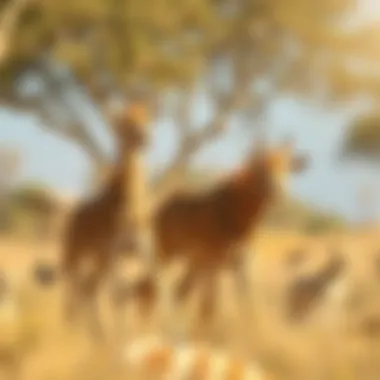
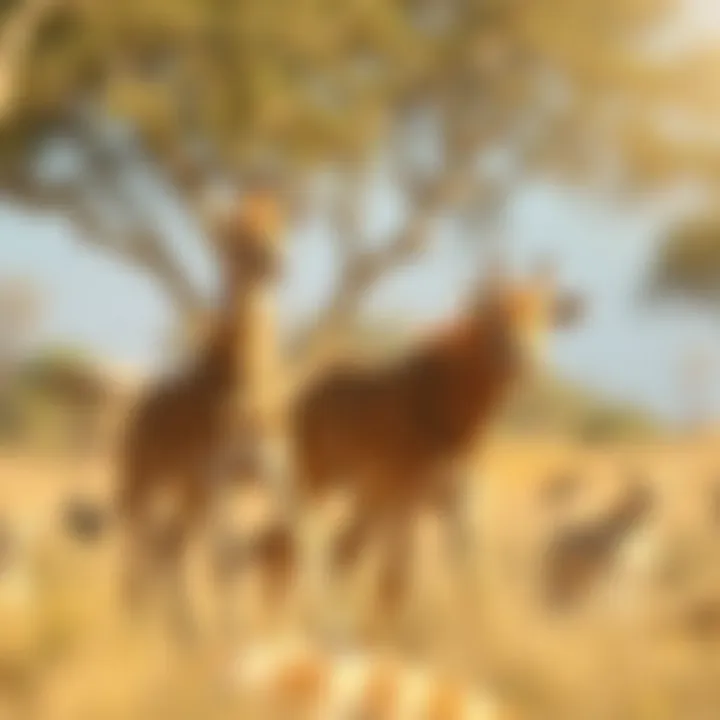
Innovations in Ecotourism
Innovations in ecotourism at the Desert Safari Park come in various forms, particularly in technology and visitor engagement strategies. One notable push is toward digital platforms that enhance visitor experience. For instance, augmented reality (AR) apps can offer visitors a unique way to interact with exhibits, bringing animals to life in a fun and immersive manner. Such innovations not only entertain but also educate, allowing visitors to learn about the species they encounter in real-time.
Additionally, the park is exploring sustainable transport solutions within its borders, such as electric shuttles to minimize the carbon footprint and enhance the overall enjoyment of the landscape. As part of their drive toward sustainability, the park is also keen on implementing community-based projects that involve local populations in conservation activities. Building partnerships with local artisans can promote traditional crafts that highlight the culture of the region while providing an income stream for residents.
The culmination of these efforts is aimed at creating a model for ecotourism that other regions can replicate, establishing the Desert Safari Park as a beacon of sustainability and innovation. Through these expansions and innovative approaches, the skpark sets itself apart as a leader in ecotourism, drawing the attention of investors and partners eager to align with responsible development initiatives.
"Sustainable practices are not just trends; they are the future of how we interact with nature."
As investors, homebuyers, and developers contemplate opportunities, recognizing the park’s forward-thinking initiatives offers a glimpse of its potential as a robust investment aligned with values of conservation and community involvement.
By carefully considering further developments and anticipating the needs of visitors, the Desert Safari Park is poised not just to thrive but to lead by example in the realm of ecotourism.
Challenges Facing the Park
Understanding the challenges facing the Desert Safari Park is crucial for recognizing its ongoing relevance and sustainability. As one of Dubai’s key attractions, the park navigates a complex landscape of environmental stewardship and operational efficiency. It’s not just about attracting visitors; it’s about balancing ecological health and tourism demands to ensure the park remains both accessible and sustainable. Without addressing these challenges, the very essence of what makes this park a unique experience could be jeopardized.
Environmental Concerns
One of the most pressing issues that the Desert Safari Park grapples with is the impact of climate change and human activity on its fragile ecosystems. Droughts, temperature fluctuations, and the encroachment of urban development all pose significant threats. The delicate harmony between the various species within the park is at risk if these concerns are not systematically addressed.
Here are some specific environmental factors to consider:
- Poisonous plants and invasive species can disrupt native habitats, leading to a decline in the local flora and fauna.
- Water scarcity due to rising temperatures may affect the survival of key desert plants and animals, impacting the overall biodiversity.
- Increased tourism can lead to litter and pollution, further exacerbating the strain on natural resources.
For the park to flourish as a center for ecotourism, initiatives need to be actively pursued that mitigate these impacts while educating visitors about the importance of preserving natural habitats.
Management and Operational Hurdles
The operational side of maintaining such a vast and diverse environment isn't a walk in the park. Challenges abound in managing resources effectively, while also ensuring visitors have a top-notch experience. Staffing, financial resources, and the integration of technology into everyday operations all require thoughtful strategic approaches.
Several hurdles the management faces include:
- Funding: Securing financial backing for ongoing projects can be tough in a competitive tourism market. Investments must be balanced with the necessity of staying true to conservation goals.
- Staff Training: Ensuring that staff members are well-versed in ecology, customer service, and emergency protocols is paramount. Continuous professional development is essential, yet it demands time and money.
- Visitor Management: High visitor numbers can lead to overcrowding, detracting from the experience for everyone involved. Effective crowd control measures must be in place to protect both the park’s resources and the enjoyment of guests.
Ultimately, the successful management of the Desert Safari Park hinges on its ability to navigate these challenges. Failure to do so risks not only harming wildlife and plant life but also diminishing the rich cultural experience the park offers.
By proactively recognizing these issues, the Desert Safari Park can enhance its mission of promoting conservation while offering an engaging experience for everyone who sets foot on its grounds.
Visitor Insights
Understanding visitor insights is crucial for grasping the true essence of the Desert Safari Park in Dubai. Insights gathered from guests not only reflect personal experiences but also highlight areas where the park excels, as well as aspects needing attention.
These insights provide valuable feedback regarding various offerings such as safari tours, cultural experiences, and facilities. By analyzing visitor reviews, potential guests can make more informed decisions when planning their escape to this vibrant destination. Furthermore, for investors and developers, these insights serve as a compass to indicate potential growth areas, ensuring that investments align with visitor preferences and needs.
Reviews and Feedback
Guest reviews encapsulate the heart of the visitor experience, acting as a mirror to the diverse offerings within the park. Many highlight the thrill of dune bashing and the serene beauty of camel riding, capturing the essence of adventure mixed with unique cultural flavor. Reviewers often appreciate the range of flora and fauna as well, noting specific species that caught their attention.
Conversely, some feedback points to the challenges that need addressing. Comments about the need for clearer signage or expanded facilities could provide critical insight for park management. Therefore, reading reviews on platforms like TripAdvisor or social media sites such as Facebook offers a detailed perspective on what visitors cherish most.
"The blend of adventure and cultural depth made our visit unforgettable. Yet, clearer pathways would surely enhance accessibility."
Such narratives reveal the diverse expectations of guests from different backgrounds, shedding light on how the park can further enhance its reputation. Engaging with tourist feedback isn’t just about receiving praise; it’s also about learning from constructive criticism to continuously improve offerings.
Photography and Documentation
Capturing the spirit of the Desert Safari Park through photography is more than just a hobby; it becomes a significant aspect of the visitor experience. Many guests share their adventures online, painting a vivid picture of their journeys filled with idyllic landscapes, rare species, and memorable moments. This shared documentation has the power to inspire future visitors while creating a sense of community among those who have explored the park.
The awe-inspiring sunsets over golden dunes or the serene moments shared between riders and camels encapsulate experiences that often cannot be put into words. Such visuals find homes in personal blogs, Instagram feeds, and even travel articles, attracting a broader audience eager to witness the magic themselves.
Moreover, the park may consider exhibitions of visitor photography to celebrate the connections forged within its borders. Highlighting visitor-generated content not only enhances engagement but also gives the park an organic touch, emphasizing its importance within the community.
Epilogue
In wrapping up our exploration of the Desert Safari Park in Dubai, it’s vital to highlight the multi-dimensional significance of this unique destination. The park is not just an attraction; it stands as a testament to the delicate equilibrium between tourism and environmental conservation. By focusing on its ecological role, recreational offerings, and sustainability initiatives, investors and potential visitors can recognize its appeal as both a prime leisure spot and a hub of responsible tourism.
First and foremost, the inherent beauty and the rich biodiversity of the park enhance its allure. Visitors are treated to a variety of ecosystems that reflect the region’s natural heritage. Exploring the desert, coastal, and mountainous habitats offers a rare chance to observe flora and fauna native to the UAE—a rich tapestry woven from nature's own blueprint. Moreover, this variety of biodiversity is central to conservation efforts, positioning the park as a field of study for sustainability.
In terms of recreational benefits, the park provides a sanctuary for adventurers and culture enthusiasts alike. From heart-pounding dune bashing to engaging cultural workshops, the offerings are diverse enough to appeal to a broad audience. These activities not only entertain but also cultivate an appreciation for the area’s rich history and traditions.
Additionally, the park serves as a catalyst for economic growth. Local tourism and investments are the lifeblood of Dubai’s economy, and attractions like the Desert Safari Park help sustain that flow. The revenue generated contributes to local communities, enhances public services, and fosters an environment that encourages expatriates and homebuyers to consider the area as a viable longer-term residence.
When looking at sustainability, the future of the Desert Safari Park is promising. Its initiatives in renewable energy and conservation programs embody a progressive mindset that resonates with modern ecotourism. This forward-thinking approach sets an example for other regions seeking to balance tourism with ecological preservation, emphasizing that economic gain does not have to come at the cost of environmental degradation.
Overall, the Desert Safari Park is a cornerstone in Dubai's quest for sustainable development and responsible tourism. Its possibilities to educate, entertain, and inspire should not be underestimated. As both visitors and investors ponder their next steps, they must consider the park not just as a destination but as a part of a broader narrative that intertwines nature, culture, and economics in an era demanding accountability and foresight in tourism practices.
"In a world increasingly aware of environmental challenges, the Desert Safari Park stands as a shining example of what can be achieved through concerted efforts in ecotourism and community engagement."



